
PHYSICS OF THE SOLID STATE
Scope & Guideline
Driving Insights in Contemporary Scientific Challenges
Introduction
Aims and Scopes
- Material Properties and Characterization:
The journal extensively covers the structural, electronic, magnetic, optical, and thermal properties of various materials, including metals, semiconductors, and insulators. This includes studies on thin films, nanostructures, and composite materials. - Nanotechnology and Nanoscale Materials:
There is a strong emphasis on nanomaterials and nanostructures, exploring their unique properties and potential applications. This includes synthesis, characterization, and applications of nanoparticles, nanowires, and quantum dots. - Magnetic and Ferroelectric Materials:
Research on magnetic materials, including ferromagnets, antiferromagnets, and ferrimagnets, is a core focus, alongside studies on ferroelectric materials and multiferroics, emphasizing their properties and applications in devices. - Computational and Theoretical Studies:
The journal publishes works employing computational methods, including first-principles calculations, molecular dynamics simulations, and theoretical modeling to predict and understand material behavior. - Optoelectronic and Photonic Applications:
There is a notable interest in the optical properties of materials and their applications in optoelectronic devices, including photodetectors, LEDs, and solar cells. - Surface and Interface Physics:
Research on surface phenomena, interface effects, and thin film technologies is frequently featured, highlighting the importance of surface properties in determining the behavior of solid-state materials.
Trending and Emerging
- Nanostructured and Composite Materials:
There is a significant increase in research related to nanostructured materials and composites, showcasing their unique properties and applications in various fields such as catalysis, sensors, and energy storage. - Advanced Magnetic Materials:
Recent publications have shown a growing interest in advanced magnetic materials, including studies on magnetocaloric effects, spintronics, and nanomagnetic systems, reflecting the trend towards functional materials for technological applications. - Optoelectronic Devices and Photonics:
Emerging themes in optoelectronics, particularly in the development of new photonic devices, LEDs, and solar cells, have gained traction, highlighting the journal's focus on practical applications of solid-state physics. - Machine Learning and AI in Material Science:
An increase in the application of machine learning and artificial intelligence techniques to predict material properties and behaviors is noticeable, indicating a shift towards data-driven approaches in materials research. - Sustainability and Green Technologies:
Research addressing sustainable materials and energy-efficient technologies is on the rise, reflecting global trends towards environmentally friendly practices in material science, including studies on biodegradable materials and renewable energy technologies.
Declining or Waning
- Bulk Material Studies:
There has been a noticeable decline in papers focused solely on bulk properties of materials, as the trend shifts towards nanoscale and thin film investigations, which are perceived to have more immediate applications. - Traditional Superconductors:
Research on conventional superconducting materials appears to be waning, with fewer studies published compared to the increasing interest in high-temperature superconductors and related phenomena. - Classical Ferromagnetism:
While ferromagnetism remains a topic of interest, studies that focus exclusively on classical ferromagnetic materials without incorporating advanced materials or novel phenomena are becoming less frequent. - Basic Thermodynamic Studies:
The journal has seen a reduction in the number of papers dedicated to fundamental thermodynamic properties of materials, as more research moves towards application-driven studies and complex systems. - Electrochemical Properties of Bulk Materials:
Research focusing on the electrochemical properties of bulk materials, as opposed to nanoscale or composite systems, is declining, likely due to a shift towards more complex and multifunctional materials.
Similar Journals
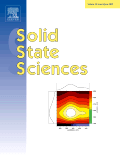
SOLID STATE SCIENCES
Exploring the Depths of Condensed MatterSOLID STATE SCIENCES is an influential academic journal published by Elsevier, focusing on advancements in the fields of chemistry, condensed matter physics, and materials science. With an ISSN of 1293-2558 and an E-ISSN of 1873-3085, this journal has been at the forefront of disseminating innovative research since its inception in 1999 and is projected to continue until 2024. Positioned in the prestigious Q2 category in multiple disciplines for 2023, SOLID STATE SCIENCES ranks #87 in condensed matter physics, #101 in general chemistry, and #124 in general materials science within Scopus. Researchers and professionals in these fields will find this journal indispensable, offering open access options that enhance global visibility and accessibility of cutting-edge research, fostering collaboration and innovation. With its commitment to showcasing substantial contributions and novel methodologies, SOLID STATE SCIENCES plays a vital role in shaping the future of materials research.
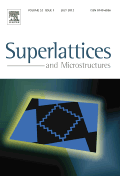
SUPERLATTICES AND MICROSTRUCTURES
Advancing the frontiers of materials science.SUPERLATTICES AND MICROSTRUCTURES is a premier journal dedicated to the exploration and dissemination of cutting-edge research in the fields of Condensed Matter Physics, Electrical and Electronic Engineering, and Materials Science. Published by Academic Press Ltd - Elsevier Science Ltd, this journal has established itself as an important platform for scholars and industry professionals to share their findings related to the design, fabrication, and application of superlattices and microstructured materials. With a commendable impact factor reflected in its rankings—positioned within the top quartile in Physics and Astronomy as well as Electrical and Electronic Engineering—it offers high visibility and influence in the academic community. The journal has covered significant contributions from 1985 to 2022, although access options have transitioned, making staying current essential for researchers and practitioners alike. This journal not only serves as a repository of knowledge but also fosters collaboration and innovation in materials science and related disciplines.
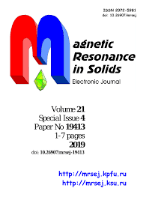
Magnetic Resonance in Solids
Championing Original Research in Magnetic ResonanceMagnetic Resonance in Solids is a pioneering open-access journal, published by Kazan Federal University in the Russian Federation since 2006. With an ISSN of 2072-5981, this journal focuses on a diverse array of disciplines within Atomic and Molecular Physics, Electronic, Optical and Magnetic Materials, Nuclear and High Energy Physics, and Spectroscopy. Although its impact factor currently places it in the fourth quartile across multiple categories, the journal provides invaluable insights into the evolving field of magnetic resonance, informing researchers and professionals alike. It features a wide range of original research articles, review papers, and technical notes that foster the exchange of knowledge in solid materials characterization through magnetic resonance techniques. Despite facing competitive rankings, its open-access nature ensures broad dissemination of critical findings, appealing to a global audience of scientists, academics, and students seeking to advance their understanding of solid-state phenomena. The journal is continuously committed to promoting high-quality research and fostering innovation in its areas of study.

JOURNAL OF ELECTRONIC MATERIALS
Connecting Researchers to Groundbreaking Insights in ElectronicsWelcome to the Journal of Electronic Materials, a premier publication in the field of materials science. Published by Springer, this esteemed journal has been a beacon for groundbreaking research in electronic, optical, and magnetic materials since its inception in 1972. As an established resource, it boasts a commendable impact factor and categorically ranks in the second quartile (Q2) in key areas such as Condensed Matter Physics and Electrical and Electronic Engineering, as well as holding a respectable third quartile ranking in fields related to Electronic, Optical, and Magnetic Materials and Materials Chemistry. Researchers, professionals, and students can access a wealth of knowledge as we publish original articles, reviews, and cutting-edge research that push the boundaries of science and technology in these critical fields. Stay informed and engaged as we explore advancements that shape the future of electronic materials.
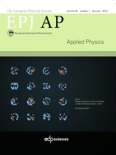
EUROPEAN PHYSICAL JOURNAL-APPLIED PHYSICS
Bridging Theory and Application in PhysicsEUROPEAN PHYSICAL JOURNAL-APPLIED PHYSICS, published by EDP SCIENCES S A in France, serves as a vital platform for the dissemination of cutting-edge research in the fields of condensed matter physics, electronic, optical and magnetic materials, and instrumentation. With an ISSN of 1286-0042 and E-ISSN of 1286-0050, this journal has been a valuable resource for researchers since its inception in 1998, aiming to foster innovation and dialogue among professionals and academics alike. Featuring an impact factor that reflects its growing influence, the journal is currently ranked in the Q4 quartile for several related categories in 2023, underscoring its ongoing contributions to the scientific community despite its relatively competitive positioning. Access to the journal is available through various Open Access options, ensuring that pioneering research is readily accessible to all. As it continues to evolve towards its 2024 objectives, EUROPEAN PHYSICAL JOURNAL-APPLIED PHYSICS remains dedicated to advancing knowledge and facilitating collaboration in applied physics, making it an essential resource for students, researchers, and professionals dedicated to exploring the forefront of physical sciences.
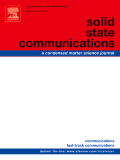
SOLID STATE COMMUNICATIONS
Connecting Researchers with Cutting-Edge DiscoveriesSOLID STATE COMMUNICATIONS is a prestigious journal published by Pergamon-Elsevier Science Ltd, dedicated to disseminating cutting-edge research in the fields of Chemistry, Condensed Matter Physics, and Materials Chemistry. With an ISSN of 0038-1098 and an E-ISSN of 1879-2766, the journal has established itself as a vital resource for researchers and professionals seeking to explore the fundamental properties and innovative applications of solid-state materials. As of 2023, it boasts a commendable standing, ranking in the Q2 quartile across its various categories, reflecting its impactful contributions to the scientific community. The journal is indexed in Scopus, further validating its relevance and quality, with notable ranks close to the median percentile in key areas. While SOLID STATE COMMUNICATIONS does not currently offer Open Access options, it remains a highly regarded source for rigorous scientific inquiry and open discussions, with a publication history dating back to 1963 and continuing to 2024. The journal serves as an essential platform for disseminating groundbreaking findings and fostering collaboration within the vibrant fields of solid state science.
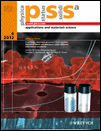
PHYSICA STATUS SOLIDI A-APPLICATIONS AND MATERIALS SCIENCE
Connecting theory with practice in materials science.PHYSICA STATUS SOLIDI A-APPLICATIONS AND MATERIALS SCIENCE, published by WILEY-V C H VERLAG GMBH, stands as a prominent journal in the fields of condensed matter physics, materials science, and engineering. With an ISSN of 1862-6300 and E-ISSN 1862-6319, this journal has been actively contributing to scientific discourse since its inception. The journal currently holds a respectable Q2 ranking across several categories including Electrical and Electronic Engineering and Materials Chemistry, demonstrating its significance in advancing research and development within these domains. Although it does not offer open access, the journal ensures high-quality peer-reviewed content that is critical for researchers and professionals aiming to stay at the forefront of materials science innovations. The journal’s convergence years, extending from 2005 to 2024, reflects its ongoing commitment to publishing impactful research. By facilitating discussions on applications and advances in materials science, PHYSICA STATUS SOLIDI A continues to be an essential resource for those striving to contribute to this dynamic field.

Lithuanian Journal of Physics
Illuminating Insights in Physics ResearchWelcome to the Lithuanian Journal of Physics, an esteemed publication helmed by the Lithuanian Physical Society, dedicated to advancing the field of physics and astronomy. Established in 2008 and continually publishing insightful research through 2024, this journal aims to provide a platform for high-quality scholarly articles that contribute to the understanding of various physical phenomena. With a steady presence in the academic landscape, the journal is currently ranked in the fourth quartile of the Physics and Astronomy category and is positioned at the 18th percentile in its Scopus ranking, reflecting its niche focus and accessibility for researchers and students alike. Although currently not operating under an open access model, the journal remains a vital resource for professionals seeking to stay informed on the latest developments in the field. The Lithuanian Journal of Physics invites contributions that inspire collaboration and innovation in physical sciences, making it an invaluable resource for the global scientific community seeking to expand knowledge within this dynamic field.

SEMICONDUCTORS
Pioneering insights in condensed matter physics.SEMICONDUCTORS, published by PLEIADES PUBLISHING INC, is a prominent journal that provides a platform for researchers and professionals in the fields of Atomic and Molecular Physics, Condensed Matter Physics, and Electronic, Optical and Magnetic Materials. With an ISSN of 1063-7826 and an E-ISSN of 1090-6479, the journal has been diligently disseminating knowledge since its inception in 1996 and continues to pave the way for innovative research until 2024. Although currently unclassified in the Open Access model, its influence is underscored by its rankings in Scopus, where it ranks in the 21st-22nd percentile across critical scientific categories. SEMICONDUCTORS serves as an essential resource for cutting-edge research, fostering a greater understanding of semiconductor materials and their applications, thereby assisting the scientific community in pushing the boundaries of technology and innovation.

Computational Condensed Matter
Illuminating the Path for Future Innovations in Materials ChemistryComputational Condensed Matter, a reputable journal published by Elsevier, serves as a critical platform for advancing the understanding of condensed matter physics and related fields. Since its inception in 2014, the journal has become a pivotal resource for researchers and professionals dedicated to exploring electronic, optical, and magnetic materials, as well as materials chemistry and general materials science. With its current standing in the Q3 quartile across multiple categories in 2023, it ranks within the 60th percentile for Materials Science (miscellaneous) and the 54th percentile for Condensed Matter Physics in Scopus, reflecting its growing influence and relevance in the scientific community. The journal aims to publish high-quality, peer-reviewed articles that can foster innovation and collaboration in computational methods applied to condensed matter systems. Researchers interested in cutting-edge insights and methodologies will find Computational Condensed Matter to be an invaluable addition to their academic resources. For those seeking to contribute to or stay informed about the latest advancements in the field, this journal is a must-read.